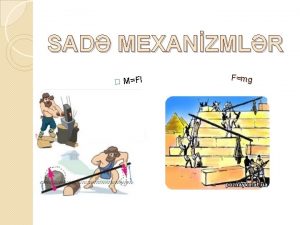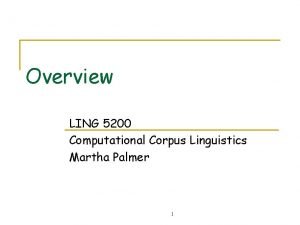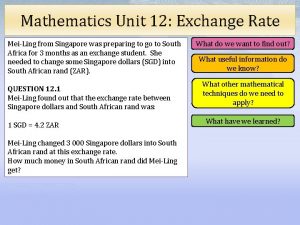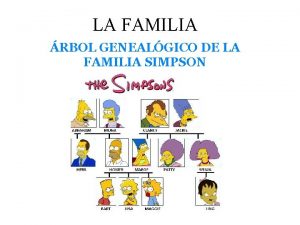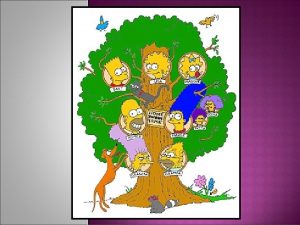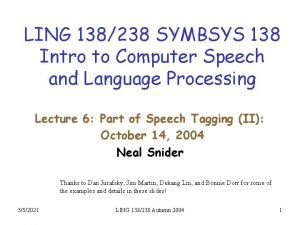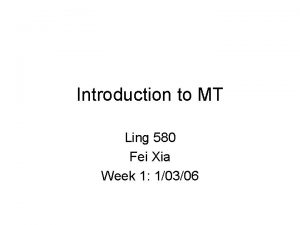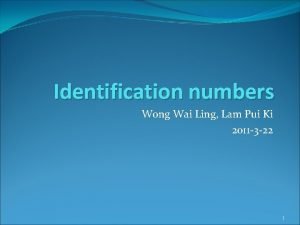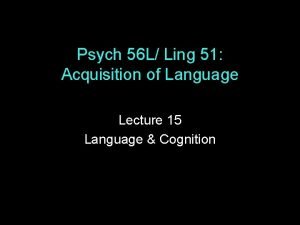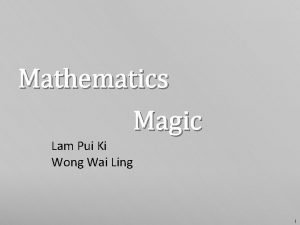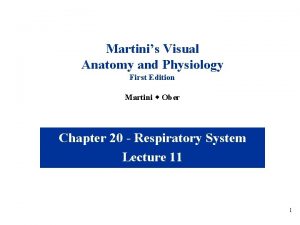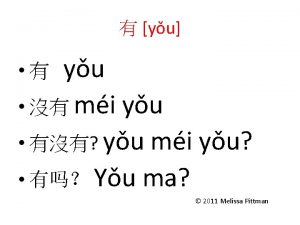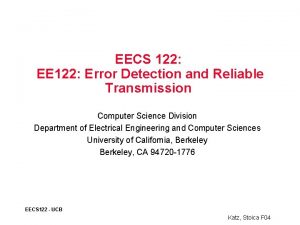LING ASIA 122 5 FRAMEWORK AND RELEVANT CONCEPTS





























- Slides: 29

LING / ASIA 122 - 5 FRAMEWORK AND RELEVANT CONCEPTS Based on Kachru and Smith, Chapter 1 and G. Tucker Childs, in The 5 -Minute Linguist

ROAD MAP Now that we’ve: defined and identified global languages, briefly outlined the history of English, described the factors that led to the prominence of English as a global language, and seen several varieties of English from around the world , . . .

ROAD MAP (cont’d) And after having taken a side trip to explore our linguistic heritages, . . .

In this week’s readings and lectures, we will. . . Review some facts about languages and dialects, and Explore some concepts that will help us better analyze what contributes to successful and less successful communication across cultures, Even when everyone is speaking the same language, i. e. , ENGLISH

Languages and Dialects: Some things to remember Everyone who speaks a language speaks a dialect; A language can be seen as a group of dialects; Dialects can be geographic – Texan, Boston, So. Cal Dialects can be social – “My Fair Lady” Dialects can be political – “… an army and a navy” Dialect differences are usually minor Pronunciation Grammar Vocabulary “Language” and “dialect” are loaded terms

Critical Concepts Forming the Basis for This Course Types of Information: conceptual, indexical, interactional-management Speech Acts, Implicature, the Cooperative Principle Conversation Analysis: Turns, Exchanges, Turn Relevance Places, Adjacency Pairs Politeness and Positive and Negative Face Context: Setting, Participants, Ends, Acts, Key, Instrumentalities, Norms, Genres

Types of Information Conceptual information: purely factual content of linguistic signals. Indexical information: information about the speaker / writer. Interactional-management information: information that allows participants to initiate, participate in and terminate interactions.

Interactional-Management Information: What we know about day-to-day interactions: ◦ How to open conversations ◦ How to hold the floor ◦ When and how to take & yield the floor ◦ How to stay on topic and to change topics ◦ How to close a conversation

Conversation Analysis – Tools to analyze interactional-management information Conversational floor – the ‘shared space’ in which a conversation takes place; participants in a conversation share the conversational floor. Turn: the distribution of talk across participants; the stretch of speech of a single speaker bounded by the speech of another speaker. Turn 1: - A : How did you like Avatar? Turn 2: - B: I thought it was great!

Conversation Analysis (cont’d) Exchange: Two or more sequential turns. For example, Exchange 1: A: Could you put this letter in the mailbox for my on your way out? B: Sure. Exchange 2: A: Could I ask you a favor? B: Sure, what is it? A: Could you put this letter in the mailbox for me on your way out? B: Sure.

Conversation Analysis (cont’d) Adjacency pair: Two successive utterances or turns by different speakers, where the second is of a type required or expected by the first. In the previous example, the exchange between A and B constitutes an adjacency pair (question and answer) Greeting -> Greeting Apology -> Minimalization Thanks -> Acknowledgement Etc.

Conversation Analysis (cont’d) Turn relevance point (TRP) – the potential boundary that marks where a turn could end, marked by one or more of the following: Phrase final intonation Grammar Eye contact Body movement Etc.

Conversation Analysis (cont’d) Repair – the conversational work required when a conversationalist fails to respond with the expected turn type Example: when a speaker fails to respond to a question with an answer Overlaps – occasions when a second speaker begins before the first speaker has finished Back-channeling – vocalizations by the listener relinquishing the floor to the current speaker ‘uh-huh’ ‘yeah’ Etc.

Indexical Information: Presenting One’s Self Politeness Principle (Lakoff 1973) ◦ Don’t impose. Pardon me. I hope I’m not bothering you, but …. ◦ Give options. Would you mind …? Could you possibly …? May I ask you to …? ◦ Make your receiver feel good. That color really looks good on you. I like your new tattoo. “Little white lies”

Indexical information (cont’d) “Face” (Brown & Levinson 1978): the public self image that every adult tries to project. Positive face: the desire of every person to be desirable to at least some others; the positive consistent selfimage or 'personality' claimed by interactants. Negative face: the desire of every person to have his/her actions be unimpeded by others; the basic claim to territories, personal preserves, rights to nondistraction—i. e. , the freedom of action and freedom from imposition.

Politeness and Face The specific nature of face varies from society to society, e. g. : Roles of parents and adult children Notions of privacy in the home, workspace The precise way of indicating respect for face may be culture specific, e. g. : Offer of a drink and initial refusal Refusal of an invitation Etc.

Speech Acts The acts we perform when uttering sentences 1955 – John Austin’s William James Lectures at Harvard (How to Do Things With Words, 1962) ◦ An utterance can constitute an act: I promise I’ll be there on time. I apologize for the way I acted.

Austin’s Criteria for Speech Acts The sentence must contain a Performative Verb – a verb that under specified conditions when uttered, constitutes the performance of an act, e. g. , ‘I promise you that I won’t be late. ’ Must be in the present tense ◦ *I promised that I wouldn’t be late. Must have a first person subject ◦ *He promises that he won’t be late. “I hereby” test ◦ I hereby promise that I won’t be late.

Felicity conditions – conditions that must be met for the utterance to constitute a valid act The person and circumstances must be appropriate: “I now pronounce you husband wife. ” The act must be executed completely and correctly be all participant: “I bet you SJSU will beat Hawai’i. ” The participants must have the appropriate intentions: “I congratulate you for your good fortune. ”

Expanding the Notion of Speech Acts 1969 – John Searle’s Speech Acts: all utterances, , not just those containing performative verbs, constitute speech acts, thus distinguishing between: Explicit Speech Acts: “I hereby christen thee ‘The Good Ship Lollipop. ’” “I sentence you to life in prison. ” Implicit Speech Acts: (I declare that) “I ran into Bill and Tony at the movies last night. ” (I ask) “What time did you get in? ” ( request that you) “Please pass the hot sauce. ”

Direct and Indirect Speech Acts Direct: an utterance whose linguistic form matches its communicative purpose, e. g. , ◦ Form = statement, Purpose = declaration ‘An amoeba is a one-celled animal. ’ ◦ Form= interrogative, Purpose = question ‘What’s your name? ’ ◦ Form = imperative, Purpose = order ‘Turn on the lights. Indirect: an utterance whose linguistic form does not match it communicative purpose, e. g. , ◦ Form = question, intent = request ‘Is that the phone? ’ ◦ Form = statement, intent = question ‘I wonder why you would say such a thing. ’

How we understand indirect speech acts: Conversational Implicature To interpret indirect speech acts, we rely on implicature, our ability to understand the speaker’s intention in uttering something e. g. , A: Is that the phone? Implicature: A wants me to answer the phone. B: I’m in the bathroom. Implicature: B wants me to know that B can’t answer the phone.

How we make implicatures: The Cooperative Principle Purpose: To describe in a systematic and consistent way how implicature works in conversation (H. P. Grice) “In conversations, participants cooperate with each other. ” (Wow! What does this mean? ? )

Operationalizing the Cooperative Principle: Conversational Maxims Quantity – contribution should be as informative as required Quality – contribution should not be false Relation – contribution should be relevant Manner – contribution should be direct Assumptions 1) We don’t adhere to them strictly. 2) We interpret what we hear as if it conforms to them. 3) Where a maxim is violated, we draw implicatures.

Violations of Maxims: Quantity ◦ Letter of reference: “Bob speaks perfect English; he doesn’t smoke in the office; and I have never heard him use foul language. ” Quality ◦ “Reno is the capital of Nevada, isn’t it? ” ◦ “Yes, and London is the capital of New Jersey”

Violations of Maxims: Relation “What time is it? ” “Well, the paper’s already come. ” Manner “Let’s stop and get something to eat. ” “OK, but not at M-c-D-o-n-a-l-d-s. ”

Violations of the Maxims "Uncle Charlie is coming over for dinner. " "Better lock up the liquor. “ "Do you know where Kendall moved? " "Somewhere on the east coast. “ "How was your blind date? " "He had a nice pair of shoes. “ “Spencer is sure he'll get that job. " “Yeah. And my pet turtle is sure it will win the Kentucky Derby. "

Context Observation: The forms that social interactions take and the meanings they embody are dependent on the context in which they are uttered: Setting: Where does the interaction take place? Participants: Who’s involved? Ends / goals: What’s the purpose of the interaction? Acts: What speech acts are employed? Key: What’s the mood / tenor of the interaction? Instrumentalities: What modes of interaction are employed (e. g. , phone, text message, face-to face, etc. ) ◦ Norms: What is the norm in this culture for this type of interaction? ◦ Genre: What kinds of genres are found in this type of interaction ◦ ◦ ◦

Activity Kachru and Smith, Pages 28 -29
 Jin ling cigarettes
Jin ling cigarettes Tərpənən tərpənməz blok
Tərpənən tərpənməz blok Ling
Ling Erin ling
Erin ling Ling oa
Ling oa Mei-ling from singapore was preparing
Mei-ling from singapore was preparing Quien es ling en los simpson
Quien es ling en los simpson Dr ng li ling
Dr ng li ling Nien-ling wacker
Nien-ling wacker 施玲玲
施玲玲 Ling simpson
Ling simpson Graph4ai
Graph4ai Archibald mclaren contribution in physical education
Archibald mclaren contribution in physical education Walter ling
Walter ling Ling
Ling Ling
Ling Ling
Ling Mtling
Mtling Wai ling lam
Wai ling lam Ling oa
Ling oa Wang ling relationship
Wang ling relationship Shi sheng ling
Shi sheng ling Ling rolled
Ling rolled Right atrium
Right atrium Negen ling
Negen ling Cheung yin ling
Cheung yin ling Magic lam
Magic lam Fir tree in lung picture
Fir tree in lung picture Short term goals examples
Short term goals examples Mei-ling huang
Mei-ling huang

